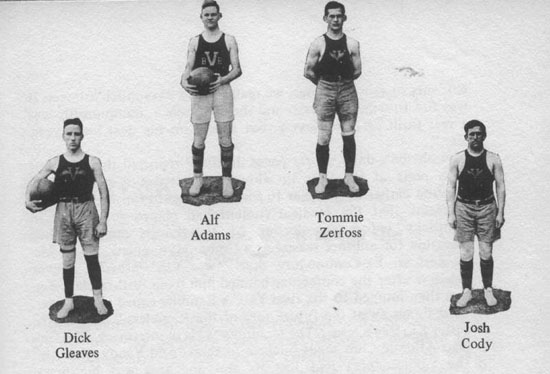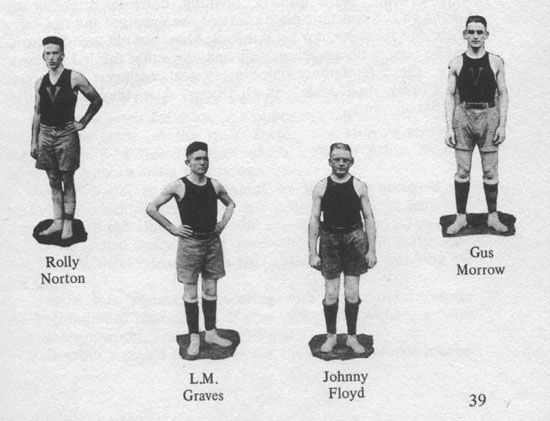March 14, 2012
Nashville sports historian Bill Traughber has recently written another book, Vanderbilt Football: Tales of Commodore Gridiron History. The 160-page paperback book can be ordered on historypress.net for $19.99.

Commodore History Corner Archive
Vanderbilt had been a member of the Southern Intercollegiate Athletic Conference (SIAA) from 1895-1924. The Commodores then became members of the Southern Conference (1924-32) and finally the Southeastern Conference (1932-present). During the 1919-20 basketball season there were about 24 teams included in the conference. Teams ranged from Texas to Florida to Kentucky, which included small colleges such as Centre (KY), Mercer and Howard (Sanford).
With such a large membership, the best record determined the championship and obviously with so many teams a true champion could not be determined. A few colleges were allowed to compete for the championship though they were not official members. Some members of the league played more conference games due to a larger number of teams in their region.
Ray Morrison, a former Commodore All-American football player and assistant football coach under Dan McGugin, coached Vanderbilt. The Commodore players were Dick Gleves, Alf Adams, Tommie Zerfoss, Josh Cody (Vandy football All-American), Rolly Norton, L. M. Graves, Johnny Floyd and Gus Morrow. During the season, Zerfoss was declared ineligible when it was discovered that he played one year of basketball at Kentucky before transferring to Vanderbilt.
The Tennessean reported on the final conference game played at the Nashville YMCA (Vanderbilt home court) against Georgia Tech:
Much of the sting of old gridiron defeats at the hands of the Tech congregation was completely wiped out by the Commodores last night when they annihilated the Yellow Jackets by the score of 32-3. Only twice during the whole game did the Techites break into the scoring column, once by a weird shot by Jenks from somewhere near the center of the floor and once when Martin sent one through the hoop on a foul shot.
The game was a riot from the start. For a long time it looked as if the big zero was a permanent fixture on Tech’s side of the scoreboard. Vandy had run up a total of 21 points before Tech came through with a single tally. At the end of the first half the score was 9-0. At the end of the game it was even worse. It was 32 to 3.
For the Commodores, Norton was the highest individual scorer, making six field goals and two fouls. He was like an eel, darting about over the floor and shooting from every place except out of bounds. Staton and Mayer gave up trying to head him off. It was too late.
The YMCA teams, within the Commodores region, dominated Vanderbilt’s schedule. These “Y” teams were in Mobile, Montgomery, Chicago, Memphis, Macon and Chattanooga. The Vanderbilt yearbook, Commodore, gave this summary of the Vanderbilt basketball players of 1919-20:
“Gaze, O Gentle Reader, upon this greatest of great forwards for the last time in garb of the Gold and Black, for Tommie Zerfoss has caged his last basket for his Alma Mater. For four long years he has held this berth, and for the last two of them, at least, he has been All-Southern Collegiate forward. The S.I.A.A powers-that-be ruled him ineligible on the four-year rule in the middle of the past season, but not before the gallant Commodore captain had won several contests by his expert dribbling, accurate passing, and deadly, sure-shot shooting from all angles.
“And now, we introduce you to another brilliant light in Southern basketball circles, Dr. Graves, the high-jumping medico. This young Apollo has held down the center job for three years, during which period he has played a good game consistently. This South-side star was ever in the thick of the fray, eternally scrapping and passing from whistle to whistle, and, at any moment, unexpectedly leaping out of a scramble and batting the globule into the netting. His work was as polished as that of any man on the team.
“The militant and pugilistic physiognomy to your left is the personal property of none other than Alf Adams. For four seasons, off and on, Alf has planted himself firmly in the hole under the enemy’s goal, and has hurled back the hostile onslaughts of all comers, big and little, Very few goals have gone over this rugged Commodore without a desperate struggle, for Shug is a power of strength. Alf always plays an aggressive game–the opponent who hesitates in shooting surely is lost. He is another mighty cog that will be missed in the 1921 basketball machine.
“Whe–ee-e Gleaves! Yes, that is the Arch-Chance posing there. He stepped up with the intention, no doubt, of making a speech, but if we can keep him still fro about two minutes we will tell you something of his basketball ability. It was he who kept Georgia Tech from shooting more than one goal, and how that happened Dick does not know. He showed real ability in that game, and since Dick has been in school but twelve years, we may expect to hear more of him.
“Here we have with us `Chicken-foot’ Morrow, the sturdy youth who rambled about at top speed as running guard of the Commodore quintet. All forwards look alike to young Morrow, and he bustled up shot after shot in both of the Rambler games. On the offensive, Morrow shifts quickly, pivoting, dodging, dribbling, or passing to the constant discomfort of the enemy, and many the time has he caged goals on one of his springing jumps, the like of which has been rarely seen on the local `Y’ floor. His style of playing is ideal for a running guard, and the Commodores are lucky to have such a man back to lead the ’20-’21 squad as captain.
“This isn’t Hercules, nor his side-kick, Atlas, nor old man Samson. Just to relieve the suspense, we’ll announce that this is Joshuway Cody, the interference-smashingest, goal-cageingest, home-run knockingest, super-athlete in all Dixie. With old Josh and Tommie, the Commodore quintet had a pair of forwards that broke through the best defense in this part of the land. Josh, in spite of his massiveness, handles himself wonderfully well, and his absence next year will leave quite a gap in the Gold and Black five, as well as a yawning chasm on the gridiron and on the diamond.
“This is Rolly, the rosy-lipped, curly-headed lad from the Windy City, where he learned many of the fine points of the old goal-caging game. `Diminutive, but deafening,’ or in common parlance, `Little, but loud’; that’s Rolly all over. Fast as a streak, and possessing an unerring eye for the old basket, Norton stepped right into Captain Zerfoss’ shoes when the latter was ruled ineligible, and darned near filled them too. This is his second year on the team, and we all expect loads from Rolly Norton in 1921.
“This young gentleman is Mr. Johnny Floyd, he of the sorrel top. Everyone knows his football, but there are some who do not know that this halfback is far from being a back in the fine art of basketball guarding. In the Georgia Tech game, he and V-chance made the Tornado look like the doldrums. His guarding was first class, and he shot a few goals just to show us that he could do it.”
Vanderbilt finished the season 14-4 with conference wins over Georgia (40-18), Georgia Tech (29-21), Centre (29-18) and Georgia Tech (32-3) in Nashville. They also defeated Maryville College (22-10) who tried to claim the title as a non-league member. The Commodores lost their final game of the season to the Nashville Ramblers their second in as many games. The Ramblers were proclaimed Nashville City champs and had been for years a city power in amateur basketball.
The Commodores were awarded the SIAA championship by going undefeated (6-0) against the college teams. The championship trophy was mailed to the Vanderbilt Athletic Association. Morrow is quoted in Roy M. Neel’s book Dynamite! 75 Years of Vanderbilt Basketball, “You’ve got to understand that since there was no real seating for students or fans, we really didn’t have much interest. It was fun to win, of course, and the conference championship was a real thrill for the players, but it was no big deal for anyone else.”

Traughber’s Tidbit: Congratulations to the `Dores on winning the 2012 SEC Tournament Championship over No.1 ranked Kentucky! It was only the second SEC Tournament championship for Vanderbilt the other coming in 1951. Just like the current season, Vanderbilt lost both regular season games to Kentucky who was ranked No. 1 each time. They defeated the No.1 Cats the third time in 1951, 61-57, in the SEC Tournament. Vanderbilt won four games in three days having to play two games on the same day. After defeating LSU 75-63, the Commodores won that same evening over Kentucky. The Wildcats went on to win the NCAA Tournament and capture their third national title.
Tidbit Two: Coach Kevin “The Whistler” Stallings entered the 2011-12 season with a coaching record at Vanderbilt of 236-148. After their three wins in the 2012 SEC Tournament, the Commodores record for the season is 24-10. Stallings updated record of 260-158 is 18 wins shy of breaking Roy Skinner’s all-time record of 278-135 (16 years). Stallings is in his 13th year leading the Commodores. Hopefully, adding a few more wins in the NCAA Tournament, Stallings should be in reach of passing Skinner next season.
If you have any comments or questions you can contact Bill Traughber via email WLTraughber@aol.com.

